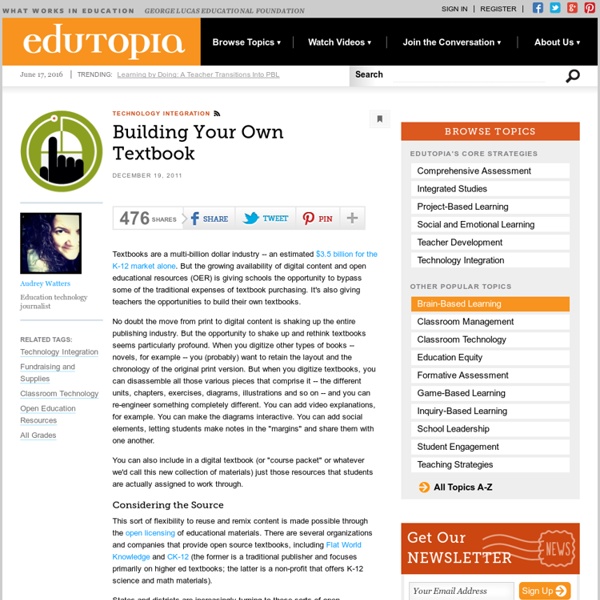Flipping the Classroom
4/27/2012 By: Teachers from around the world have adopted the flipped classroom model and are using it to teach a variety of courses to students of all ages. In the excerpt below from the book, Flip Your Classroom (©2012, ISTE® International Society for Technology in Education and ASCD), authors Jonathan Bergmann and Aaron Sams outline reasons why educators should consider this model. Flipping speaks the language of today’s students. Flipping helps busy students. Flipping helps struggling students. Flipping helps students of all abilities to excel. Flipping allows students to pause and rewind their teacher. Flipping increases student–teacher interaction. Flipping changes classroom management. Flipping educates parents. Flipping makes your class transparent. Flipping is a great technique for absent teachers. Flipping can lead to the flipped-mastery program. VIDEO TIP: MAKING A ONE-TAKE VIDEO By Michael Gorman Assign the Groups In the spirit of PBL, students should be divided into groups.
100 Free Foreign Language Classes Online | AccreditedOnlineColle
March 1st, 2010 If you have always wanted to learn a language but were too put off by the high cost associated with most classes, then take a look at all these great opportunities to learn a foreign language online, at no cost to you. With so many learning opportunities online, it is a shame not to take advantage of all that you can, so be sure to spend some time with these classes. Whether you want to learn one of the major world languages or want something a little less popular, there are sure to be lessons here to help you start to speak whatever language you are interested in learning. French If you want to learn French, no matter your experience level, then check out these free classes. BBC Languages French. Spanish From the basics to more advanced college courses in Spanish, see what is available in this listing. Learn Spanish. German Learn German from these free classes. BBC Languages German. Italian Italian Language Course. Portuguese BBC Languages Portuguese. Japanese Chinese Chinese I.
Five Best Practices for the Flipped Classroom
Ok, I'll be honest. I get very nervous when I hear education reformists and politicians tout how "incredible" the flipped-classroom model, or how it will "solve" many of the problems of education. It doesn't solve anything. It fosters the "guide on the side" mentality and role, rather than that of the "sage of the stage." It also creates the opportunity for differentiated roles to meet the needs of students through a variety of instructional activities. 1) Need to Know How are you creating a need to know the content that is recorded? 2) Engaging Models One of the best way to create the "need to know" is to use a pedagogical model that demands this. 3) Technology What technology do you have to support the flipped classroom? 4) Reflection Every time you have students watch a video, just like you would with any instructional activity, you must build in reflective activities to have students think about what they learned, how it will help them, its relevance, and more. 5) Time and Place
How to Create Your Own Online Course: 100 Tools, Guides, and Resources
How to Create Your Own Online Course: 100 Tools, Guides, and Resources Perhaps you have a special skill, talent, or knowledge-base that you want to share with others, and maybe you’ve heard that teaching online courses can make you a little extra money. The resources below will help you discover how to combine both what you have to offer and what you wish to gain by guiding you through creating and establishing an online course. No matter what age of student, subject you want to teach, or size of the class, you will find resources and information to bring your class online. Learning Management Systems Learning Management Systems host your online class and provide a place for students to receive and turn in assignments, class communication, and more. Moodle. Resources for Getting Your Class Online Read these articles to find out everything from using a free blog to host your class to selecting and implementing a Learning Management System. How to Teach an Online Course using WordPress.
Should You Flip Your Classroom?
At its core, "flipped instruction" refers to moving aspects of teaching out of the classroom and into the homework space. With the advent of new technologies, specifically the ability to record digitally annotated and narrated screencasts, instructional videos have become a common medium in the flipped classroom. Although not limited to videos, a flipped classroom most often harnesses different forms of instructional video published online for students. Despite recent buzz, catalyzed primarily by Salman Khan's TED talk, flipped instruction is by no means a new methodology. The Pros Advocates of the flipped classroom point to its potential as a time-shifting tool. ". . . the focus of flipped teaching is different from other examples in that the technology itself is simply a tool for flexible communication that allows educators to differentiate instruction to meet individual student needs and spend more time in the classroom focused on collaboration and higher-order thinking." And Cons
Education and Information Technologies
This is the official journal of the IFIP Technical Committee on Education. It covers the complex relationships between information and communication technologies and education. The journal provides perspectives at all levels, from the micro of specific applications or instances of use in classrooms to macro concerns of national policies and major projects; from classes of five year olds to adults in tertiary institutions; from teachers and administrators, to researchers and designers; from institutions to open, distance and lifelong learning. This breadth of coverage allows Education and Information Technologies to examine fundamental issues at all levels, discuss specific instances and cases, draw inference and probe theory. This journal is embedded in the research and practice of professionals. hide This is the official journal of the IFIP Technical Committee on Education.
IALLT | International Association for Language Learning Technology Where technology speaks your language



